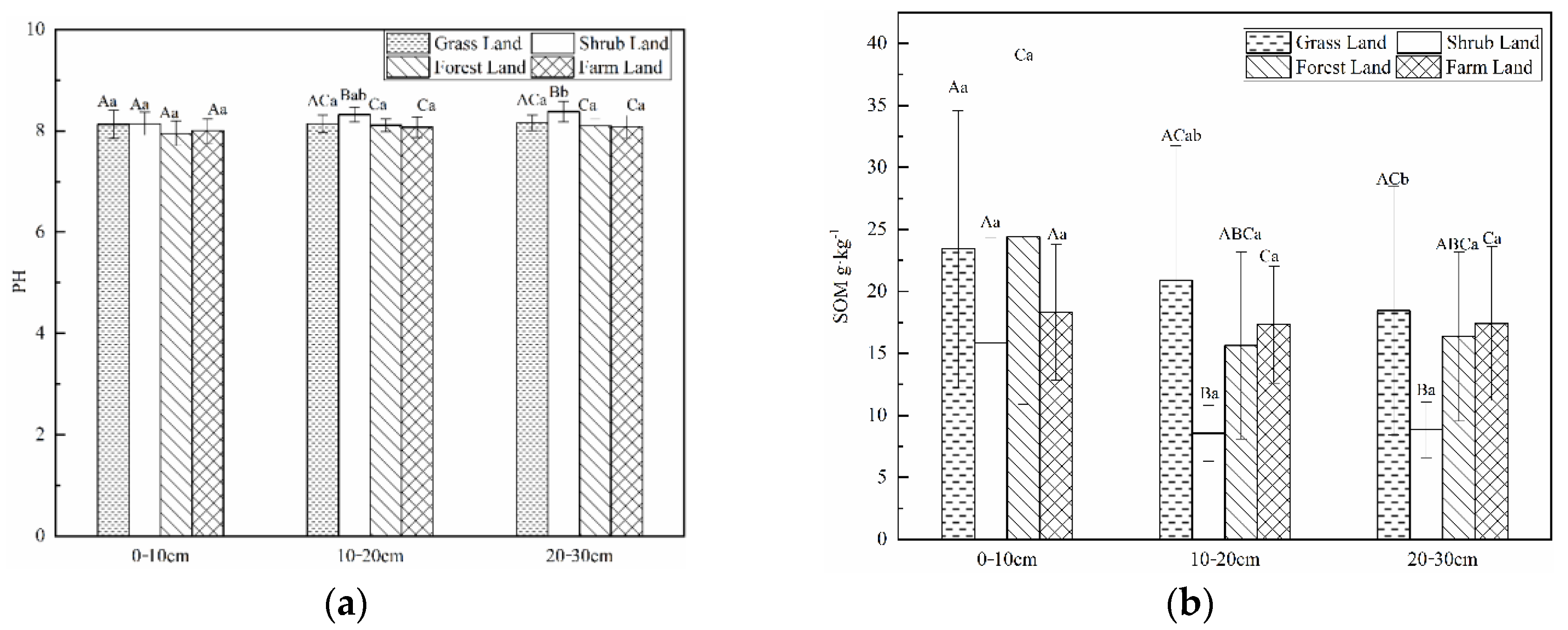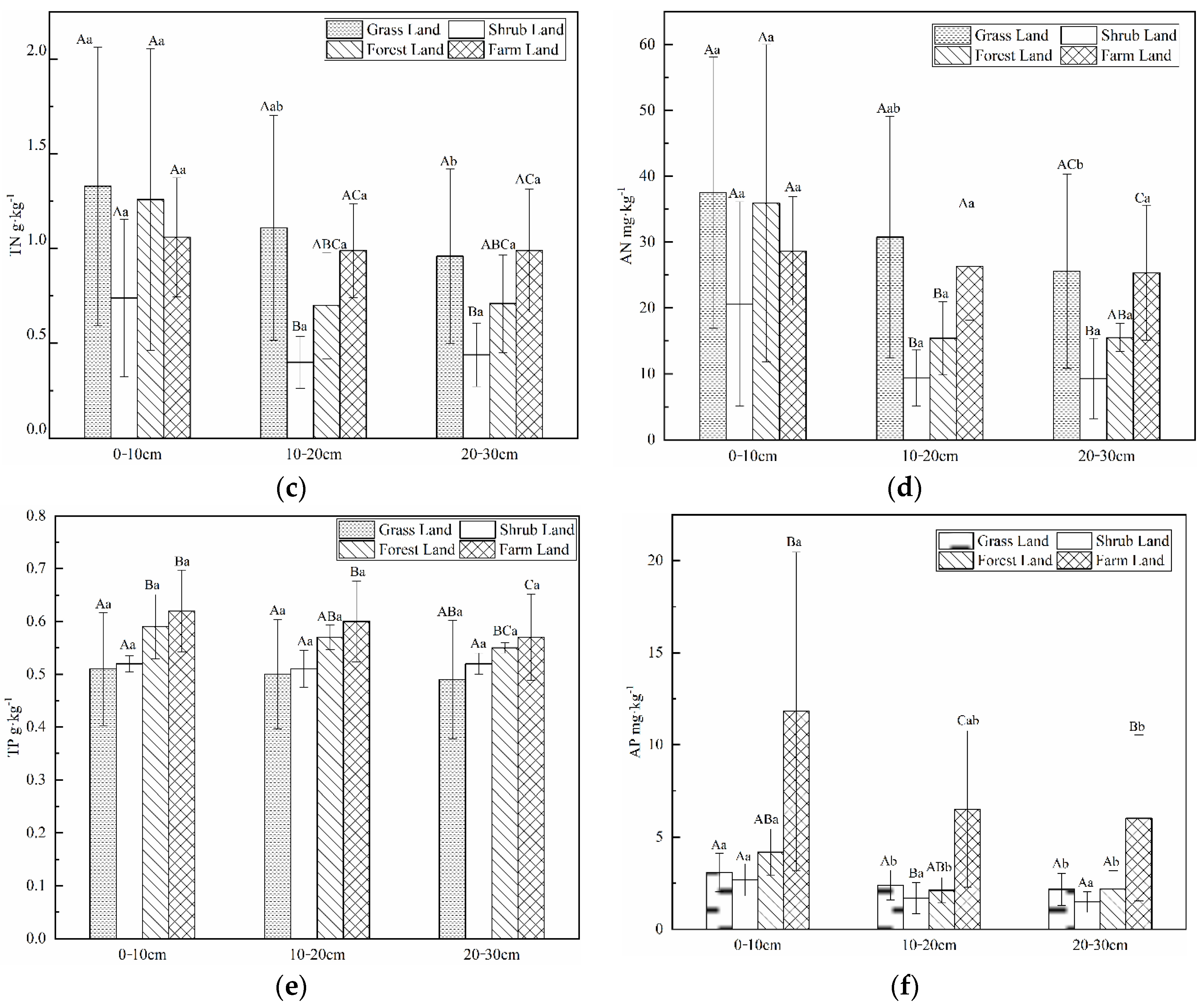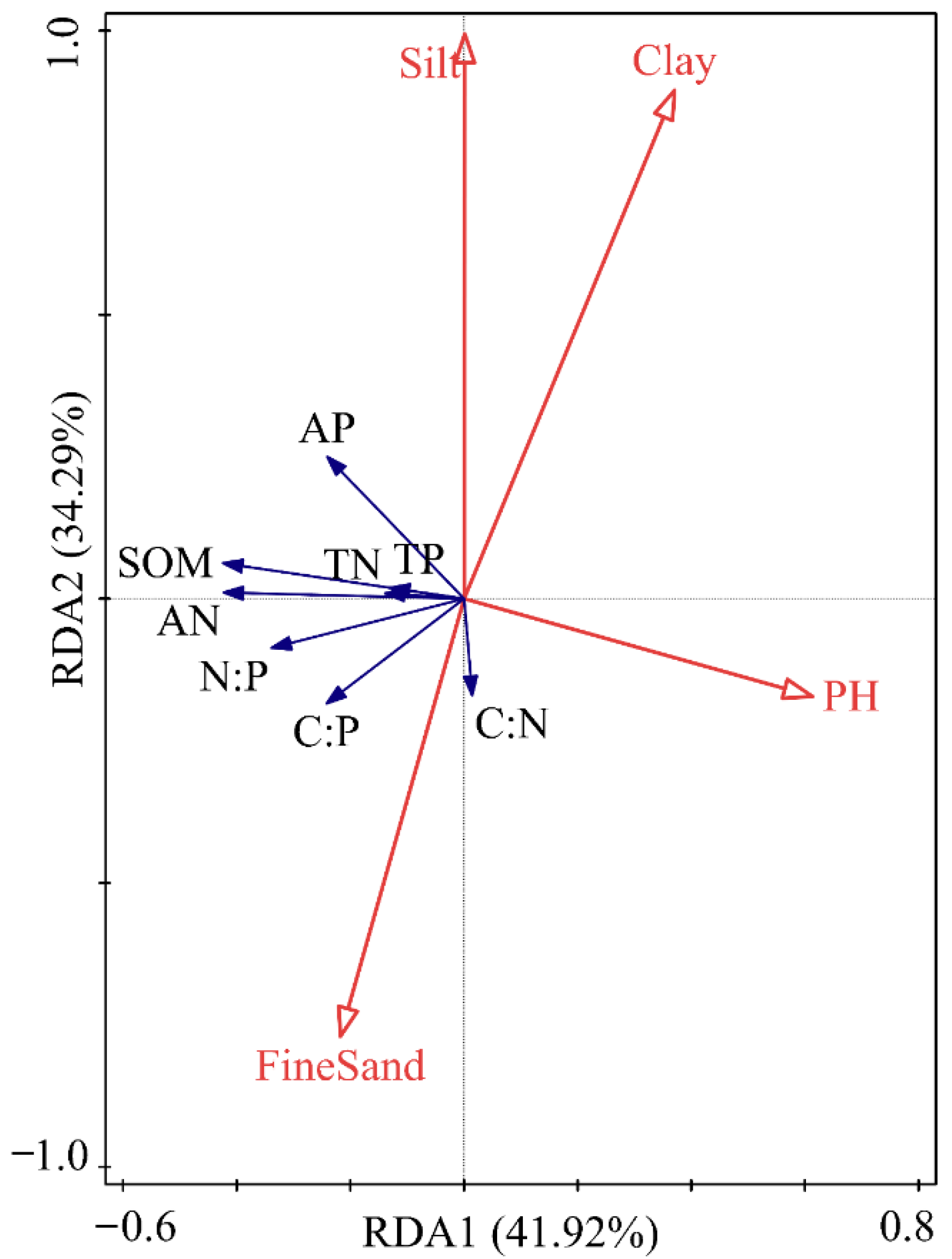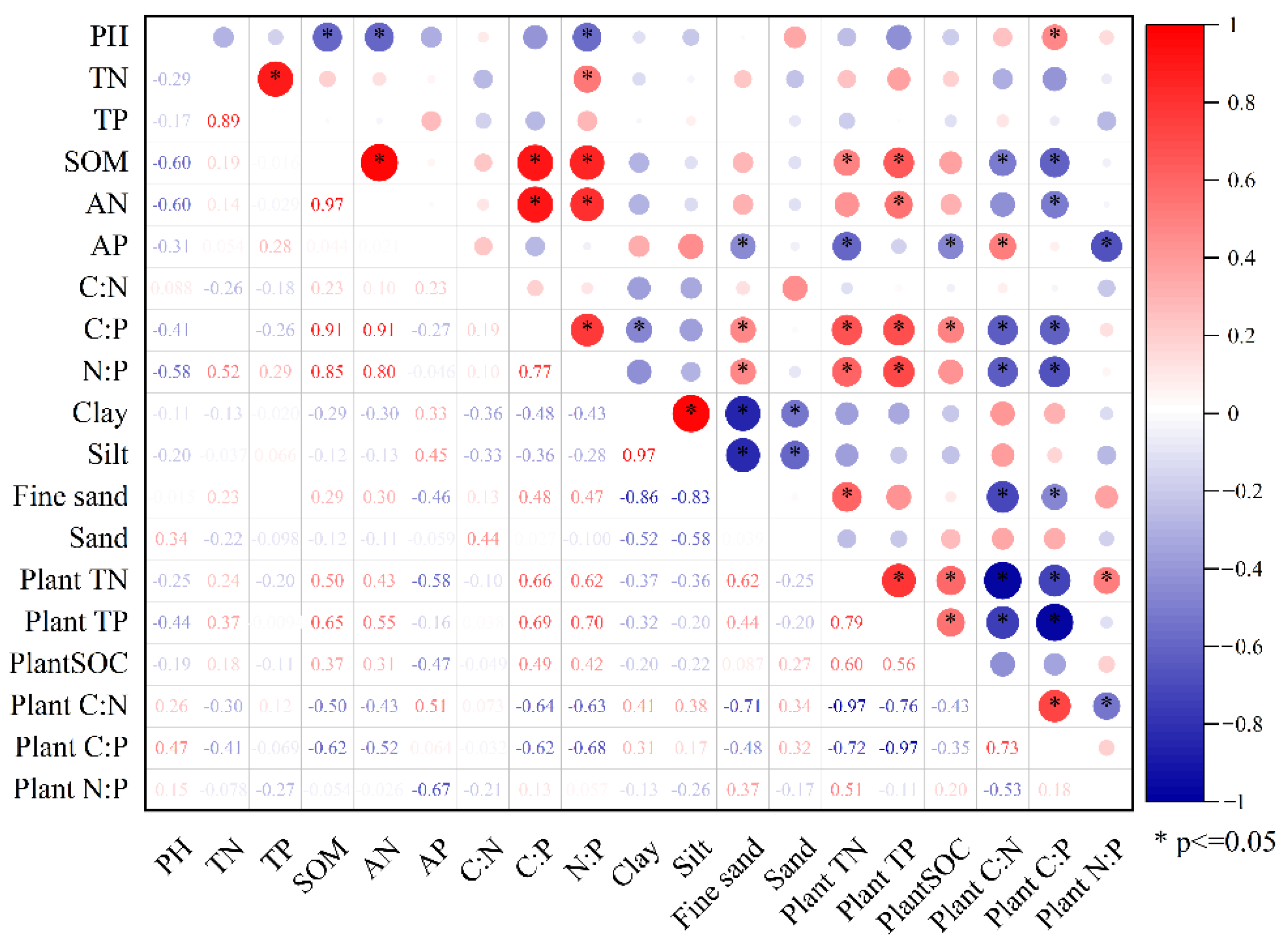Characteristics of Soil Nutrients and Their Ecological Stoichiometry in Different Land Use Types in the Nianchu River Basin
Abstract
:1. Introduction
2. Materials and Methods
2.1. Study Area
2.2. Soil Sampling and Data Sources
2.3. Data Analysis
3. Results
3.1. Changes in Soil SOM, N and P Contents under Different Land Use Types
3.2. Analysis of Soil Nutrient Stoichiometric Ratios under Different Land-Use Types
3.3. Relationship between Soil Nutrient Stoichiometric Ratios and Basic Physicochemical Properties
4. Discussion
4.1. Effect of Land-Use Type on Soil Nutrients
4.2. Characteristics of Soil C, N, and P Stoichiometric Ratios in Different Land-Use Types
5. Conclusions
Author Contributions
Funding
Institutional Review Board Statement
Informed Consent Statement
Data Availability Statement
Conflicts of Interest
References
- Tang, X.; Hu, J.; Lu, Y.; Qiu, J.; Dong, Y.; Li, B. Soil C, N, P stocks and stoichiometry as related to land use types and erosion conditions in lateritic red soil region, south China. Catena 2022, 210, 105888. [Google Scholar] [CrossRef]
- Chen, X.; Chen, H.Y.H. Plant mixture balances terrestrial ecosystem C:N:P stoichiometry. Nat. Commun. 2021, 12, 4562. [Google Scholar] [CrossRef] [PubMed]
- Wang, L.; Zhang, G.; Zhu, P.; Xing, S.; Wang, C. Soil C, N and P contents and their stoichiometry as affected by typical plant communities on steep gully slopes of the Loess Plateau, China. Catena 2022, 208, 105740. [Google Scholar] [CrossRef]
- Bai, X.; Wang, B.; An, S.; Zeng, Q.; Zhang, H. Response of forest species to C:N:P in the plant-litter-soil system and stoichiometric homeostasis of plant tissues during afforestation on the Loess Plateau, China. Catena 2019, 183, 104186. [Google Scholar] [CrossRef]
- Zeng, Q.; Liu, Y.; Fang, Y.; Ma, R.; Lal, R.; An, S.; Huang, Y. Impact of vegetation restoration on plants and soil C:N:P stoichiometry on the Yunwu Mountain Reserve of China. Ecol. Eng. 2017, 109, 92–100. [Google Scholar] [CrossRef]
- Zechmeister-Boltenstern, S.; Keiblinger, K.M.; Mooshammer, M.; Peñuelas, J.; Richter, A.; Sardans, J.; Wanek, W. The application of ecological stoichiometry to plant–microbial–soil organic matter transformations. Ecol. Monogr. 2015, 85, 133–155. [Google Scholar] [CrossRef] [Green Version]
- Liu, X.; Peñuelas, J.; Sardans, J.; Fang, Y.; Wiesmeier, M.; Wu, L.; Chen, X.; Chen, Y.; Jin, Q.; Wang, W. Response of soil nutrient concentrations and stoichiometry, and greenhouse gas carbon emissions linked to change in land-use of paddy fields in China. Catena 2021, 203, 105326. [Google Scholar] [CrossRef]
- Ostrowska, A.; Porębska, G. Assessment of the C/N ratio as an indicator of the decomposability of organic matter in forest soils. Ecol. Indic. 2015, 49, 104–109. [Google Scholar] [CrossRef]
- Zhang, W.; Zhao, J.; Pan, F.; Li, D.; Chen, H.; Wang, K. Changes in nitrogen and phosphorus limitation during secondary succession in a karst region in southwest China. Plant Soil 2015, 391, 77–91. [Google Scholar] [CrossRef]
- Zheng, S.; Xia, Y.; Hu, Y.; Chen, X.; Rui, Y.; Gunina, A.; He, X.; Ge, T.; Wu, J.; Su, Y.; et al. Stoichiometry of carbon, nitrogen, and phosphorus in soil: Effects of agricultural land use and climate at a continental scale. Soil Tillage Res. 2021, 209, 104903. [Google Scholar] [CrossRef]
- Qi, Y.; Chen, T.; Pu, J.; Yang, F.; Shukla, M.K.; Chang, Q. Response of soil physical, chemical and microbial biomass properties to land use changes in fixed desertified land. Catena 2018, 160, 339–344. [Google Scholar] [CrossRef]
- Jiao, S.; Li, J.; Li, Y.; Xu, Z.; Kong, B.; Li, Y.; Shen, Y. Variation of soil organic carbon and physical properties in relation to land uses in the Yellow River Delta, China. Sci. Rep. 2020, 10, 20317. [Google Scholar] [CrossRef] [PubMed]
- Crovo, O.; Aburto, F.; Albornoz, M.F.; Southard, R. Soil type modulates the response of C, N, P stocks and stoichiometry after native forest substitution by exotic plantations. Catena 2021, 197, 104997. [Google Scholar] [CrossRef]
- Gao, Y.; He, N.; Yu, G.; Chen, W.; Wang, Q. Long-term effects of different land use types on C, N, and P stoichiometry and storage in subtropical ecosystems: A case study in China. Ecol. Eng. 2014, 67, 171–181. [Google Scholar] [CrossRef]
- Tian, Y.Q.; Xu, X.L.; Song, M.H.; Zhou, C.P.; Gao, Q.; Ouyang, H. Carbon sequestration in two alpine soils on the Tibetan Plateau. J. Integr. Plant Biol. 2009, 51, 900–905. [Google Scholar] [CrossRef] [PubMed]
- Liu, R.; Wang, D. Soil C, N, P and K stoichiometry affected by vegetation restoration patterns in the alpine region of the Loess Plateau, Northwest China. PLoS ONE 2020, 15, e0241859. [Google Scholar] [CrossRef] [PubMed]
- Liu, X.; Ma, J.; Ma, Z.-W.; Li, L.-H. Soil nutrient contents and stoichiometry as affected by land-use in an agro-pastoral region of northwest China. Catena 2017, 150, 146–153. [Google Scholar] [CrossRef]
- Wang, F.-P.; Wang, X.-C.; Yao, B.-Q.; Zhang, Z.-H.; Shi, G.-X.; Ma, Z.; Chen, Z.; Zhou, H.-K. Effects of land-use types on soil organic carbon stocks: A case study across an altitudinal gradient within a farm-pastoral area on the eastern Qinghai-Tibetan Plateau, China. J. Mt. Sci. 2018, 15, 2693–2702. [Google Scholar] [CrossRef]
- Huaguo, Z. The ecological environment problems and Countermeasures of developing agricultural ecological resources in Tibet basin “YLN” and the economic development in the new period. Tibet J. Agric. Sci. 2017, 39, 40–44. [Google Scholar]
- Wang, Z.; He, K.; Zhu, S.; Pu, B. Characteristics of soil macrofauna community in the Nianchu river basin, Tibet. J. Arid Land Resour. Environ. 2021, 35, 184–190. [Google Scholar]
- Shi, D.; Tan, H.; Chen, X.; Rao, W.; Issombo, H.E.; Basang, R. Temporal and spatial variations of runoff composition revealed by isotopic signals in Nianchu River catchment, Tibet. J. Hydro-Environ. Res. 2021, 37, 1–12. [Google Scholar] [CrossRef]
- Li, Z.; Yao, T.; Ye, Q.; Tian, L.; Wang, W. Glaciers in the Upstream Manla Reservoir in the Nianchu River Basin, Tibet:Shrinkage and Impact. J. Glaciol. Geocryol. 2010, 32, 650–658. [Google Scholar]
- Zhou, C.; Yang, W.; Wu, L.; Liu, S. Glacier changes from a new inventory, Nianchu river basin, Tibetan Plateau. Ann. Glaciol. 2009, 50, 87–92. [Google Scholar] [CrossRef] [Green Version]
- Monteiro, J.C.; Barker, G.; Ferguson, K.M.; Wiltshaw, E.; Neville, A.M. Ectopic production of human chorionic gonadotrophin (hCG) and human placental lactogen (hPL) by ovarian carcinoma. Eur. J. Cancer Clin. Oncol. 1983, 19, 173–178. [Google Scholar] [CrossRef]
- Wang, W.; Wang, C.; Sardans, J.; Tong, C.; Jia, R.; Zeng, C.; Peñuelas, J. Flood regime affects soil stoichiometry and the distribution of the invasive plants in subtropical estuarine wetlands in China. Catena 2015, 128, 144–154. [Google Scholar] [CrossRef] [Green Version]
- He, Y.; Han, X.; Wang, X.; Wang, L.; Liang, T. Long-term ecological effects of two artificial forests on soil properties and quality in the eastern Qinghai-Tibet Plateau. Sci. Total Environ. 2021, 796, 148986. [Google Scholar] [CrossRef] [PubMed]
- Fang, X.; Xue, Z.; Li, B.; An, S. Soil organic carbon distribution in relation to land use and its storage in a small watershed of the Loess Plateau, China. Catena 2012, 88, 6–13. [Google Scholar] [CrossRef]
- McGuirk Flynn, A. Organic Matter and Nutrient Cycling in a Coastal Plain Estuary: Carbon, Nitrogen, and Phosphorus Distributions, Budgets, and Fluxes. J. Coast. Res. 2008, 10055, 76–94. [Google Scholar] [CrossRef] [Green Version]
- Ye, R.; Wright, A.L.; Inglett, K.; Wang, Y.; Ogram, A.V.; Reddy, K.R. Land-Use Effects on Soil Nutrient Cycling and Microbial Community Dynamics in the Everglades Agricultural Area, Florida. Commun. Soil Sci. Plant Anal. 2009, 40, 2725–2742. [Google Scholar] [CrossRef]
- Wang, T.; Kang, F.; Cheng, X.; Han, H.; Ji, W. Soil organic carbon and total nitrogen stocks under different land uses in a hilly ecological restoration area of North China. Soil Tillage Res. 2016, 163, 176–184. [Google Scholar] [CrossRef]
- Wei, X.; Shao, M.; Fu, X.; Horton, R.; Li, Y.; Zhang, X. Distribution of soil organic C, N and P in three adjacent land use patterns in the northern Loess Plateau, China. Biogeochemistry 2009, 96, 149–162. [Google Scholar] [CrossRef]
- Zhang, C.; Liu, G.; Xue, S.; Sun, C. Soil organic carbon and total nitrogen storage as affected by land use in a small watershed of the Loess Plateau, China. Eur. J. Soil Biol. 2013, 54, 16–24. [Google Scholar] [CrossRef]
- Su, F.; Hao, M.; Wei, X. Soil organic C and N dynamics as affected by 31 years cropping systems and fertilization in highland agroecosystems. Agric. Ecosyst. Environ. 2022, 326, 107769. [Google Scholar] [CrossRef]
- Li, C.; Zhao, L.; Sun, P.; Zhao, F.; Kang, D.; Yang, G.; Han, X.; Feng, Y.; Ren, G. Deep Soil C, N, and P Stocks and Stoichiometry in Response to Land Use Patterns in the Loess Hilly Region of China. PLoS ONE 2016, 11, e0159075. [Google Scholar] [CrossRef]
- Wu, X.; Fang, H.; Zhao, Y.; Smoak, J.M.; Li, W.; Shi, W.; Sheng, Y.; Zhao, L.; Ding, Y. A conceptual model of the controlling factors of soil organic carbon and nitrogen densities in a permafrost-affected region on the eastern Qinghai-Tibetan Plateau. J. Geophys. Res. Biogeosci. 2017, 122, 1705–1717. [Google Scholar] [CrossRef]
- Mendes, L.W.; de Lima Brossi, M.J.; Kuramae, E.E.; Tsai, S.M. Land-use system shapes soil bacterial communities in Southeastern Amazon region. Appl. Soil Ecol. 2015, 95, 151–160. [Google Scholar] [CrossRef]
- Zhao, Q.; Bai, J.; Zhang, G.; Jia, J.; Wang, W.; Wang, X. Effects of water and salinity regulation measures on soil carbon sequestration in coastal wetlands of the Yellow River Delta. Geoderma 2018, 319, 219–229. [Google Scholar] [CrossRef]
- Abrar, M.M.; Xu, H.; Aziz, T.; Sun, N.; Mustafa, A.; Aslam, M.W.; Shah, S.A.A.; Mehmood, K.; Zhou, B.; Ma, X.; et al. Carbon, nitrogen, and phosphorus stoichiometry mediate sensitivity of carbon stabilization mechanisms along with surface layers of a Mollisol after long-term fertilization in Northeast China. J. Soils Sediments 2020, 21, 705–723. [Google Scholar] [CrossRef]
- Li, C.; Li, Q.; Zhao, L.; Ge, S.; Chen, D.; Dong, Q.; Zhao, X. Land-use effects on organic and inorganic carbon patterns in the topsoil around Qinghai Lake basin, Qinghai-Tibetan Plateau. Catena 2016, 147, 345–355. [Google Scholar] [CrossRef]
- Gao, X.L.; Li, X.; Zhao, L.; Kuzyakov, Y. Shrubs magnify soil phosphorus depletion in Tibetan meadows: Conclusions from C:N:P stoichiometry and deep soil profiles. Sci. Total Environ. 2021, 785, 147320. [Google Scholar] [CrossRef]
- Ding, W.; Cong, W.F.; Lambers, H. Plant phosphorus-acquisition and -use strategies affect soil carbon cycling. Trends Ecol. Evol. 2021, 36, 899–906. [Google Scholar] [CrossRef]
- Chen, L.; Zhang, C.; Duan, W. Temporal variations in phosphorus fractions and phosphatase activities in rhizosphere and bulk soil during the development of Larix olgensis plantations. J. Plant Nutr. Soil Sci. 2015, 179, 67–77. [Google Scholar] [CrossRef]
- Mng’ong’o, M.; Munishi, L.K.; Ndakidemi, P.A. Characterization of land use influence on soil phosphate bioavailability in Usangu agro-ecosystem-Tanzania. Environ. Chall. 2021, 5, 100259. [Google Scholar] [CrossRef]
- Ma, R.; Hu, F.; Liu, J.; Wang, C.; Wang, Z.; Liu, G.; Zhao, S. Shifts in soil nutrient concentrations and C:N:P stoichiometry during long-term natural vegetation restoration. PeerJ 2020, 8, e8382. [Google Scholar] [CrossRef] [PubMed]
- Zhang, Y.; Li, P.; Liu, X.; Xiao, L.; Shi, P.; Zhao, B. Effects of farmland conversion on the stoichiometry of carbon, nitrogen, and phosphorus in soil aggregates on the Loess Plateau of China. Geoderma 2019, 351, 188–196. [Google Scholar] [CrossRef]
- Tian, H.; Chen, G.; Zhang, C.; Melillo, J.M.; Hall, C.A.S. Pattern and variation of C:N:P ratios in China’s soils: A synthesis of observational data. Biogeochemistry 2009, 98, 139–151. [Google Scholar] [CrossRef]
- Fazhu, Z.; Jiao, S.; Chengjie, R.; Di, K.; Jian, D.; Xinhui, H.; Gaihe, Y.; Yongzhong, F.; Guangxin, R. Land use change influences soil C, N, and P stoichiometry under ‘Grain-to-Green Program’ in China. Sci. Rep. 2015, 5, 10195. [Google Scholar] [CrossRef] [Green Version]
- Yan, X.; Yang, W.; Muneer, M.A.; Zhang, S.; Wang, M.; Wu, L. Land-use change affects stoichiometric patterns of soil organic carbon, nitrogen, and phosphorus in the red soil of Southeast China. J. Soils Sediments 2021, 21, 2639–2649. [Google Scholar] [CrossRef]
- Huang, Y.; Liang, C.; Duan, X.; Chen, H.; Li, D. Variation of microbial residue contribution to soil organic carbon sequestration following land use change in a subtropical karst region. Geoderma 2019, 353, 340–346. [Google Scholar] [CrossRef]
- Heping, M.; Xingle, Q.; Zhu, D.; Yuzhen, L. Effect of different land use patterns on soil microbial biomass carbon and nitrogen in the lower reaches of Niyan river of Tibet. J. Gansu Agric. Univ. 2021, 56, 117–125. [Google Scholar] [CrossRef]
- Zhou, Y.; Boutton, T.W.; Wu, X.B. Soil C:N:P stoichiometry responds to vegetation change from grassland to woodland. Biogeochemistry 2018, 140, 341–357. [Google Scholar] [CrossRef]
- Han, Y.; Dong, S.; Zhao, Z.; Sha, W.; Li, S.; Shen, H.; Xiao, J.; Zhang, J.; Wu, X.; Jiang, X.; et al. Response of soil nutrients and stoichiometry to elevated nitrogen deposition in alpine grassland on the Qinghai-Tibetan Plateau. Geoderma 2019, 343, 263–268. [Google Scholar] [CrossRef]
- He, M.; Zhou, G.; Yuan, T.; Groenigen, K.J.; Shao, J.; Zhou, X.; Xu, X. Grazing intensity significantly changes the C:N:P stoichiometry in grassland ecosystems. Glob. Ecol. Biogeogr. 2019, 29, 355–369. [Google Scholar] [CrossRef]
- Zhang, H.; Ouyang, Z.; Jiang, P.; Li, M.; Zhao, X. Spatial distribution patterns and influencing factors of soil carbon, phosphorus, and C:P ratio on farmlands in southeastern China. Catena 2022, 216, 106409. [Google Scholar] [CrossRef]
- Liu, X.; Li, L.; Wang, Q.; Mu, S. Land-use change affects stocks and stoichiometric ratios of soil carbon, nitrogen, and phosphorus in a typical agro-pastoral region of northwest China. J. Soils Sediments 2018, 18, 3167–3176. [Google Scholar] [CrossRef]
- Zhang, J.; Li, M.; Xu, L.; Zhu, J.; Dai, G.; He, N. C:N:P stoichiometry in terrestrial ecosystems in China. Sci. Total Environ. 2021, 795, 148849. [Google Scholar] [CrossRef]
- Chen, J.; Qu, M.; Wang, Y.; Huang, B.; Zhao, Y. A joint standard-exceeding risk assessment of multiple pollutants based on robust geostatistics with categorical land-use type data: A case study of soil nitrogen and phosphorus. Environ. Pollut 2022, 299, 118901. [Google Scholar] [CrossRef]
- Du, Y.; Dawa; Cheng, Q. Farnland Soil Nitrogen and Phosphorus Dynamic of One River and Two Streams in Tibet. Tibet J. Agric. Sci. 2017, 39, 10–14. [Google Scholar]
- Yang, Y.H.; Fang, J.Y.; Guo, D.L.; Ji, C.J.; Ma, W.H. Vertical patterns of soil carbon, nitrogen and carbon: Nitrogen stoichiometry in Tibetan grasslands. Biogeosci. Discuss. 2010, 7, 1–24. [Google Scholar] [CrossRef]
- Hui, D.; Yang, X.; Deng, Q.; Liu, Q.; Wang, X.; Yang, H.; Ren, H. Soil C:N:P stoichiometry in tropical forests on Hainan Island of China: Spatial and vertical variations. Catena 2021, 201, 105228. [Google Scholar] [CrossRef]







| Indicators | Grassland | Shrubland | Forestland | Farmland | ||||||||
|---|---|---|---|---|---|---|---|---|---|---|---|---|
| SD | Av | Cv (%) | SD | Av | Cv (%) | SD | Av | Cv (%) | SD | Av | Cv (%) | |
| pH | 0.20 | 8.15 A | 2.50 | 0.21 | 8.28 B | 2.55 | 0.18 | 8.05 AC | 2.22 | 0.22 | 8.05 C | 2.74 |
| SOM (g·kg−1) | 10.78 | 20.93 A | 51.52 | 6.02 | 11.08 B | 54.36 | 10.03 | 18.80 AC | 53.37 | 5.42 | 17.68 AC | 30.68 |
| TN (g·kg−1) | 0.61 | 1.10 AC | 55.18 | 0.29 | 0.53 B | 55.65 | 0.54 | 0.89 A | 61.06 | 0.30 | 1.01 C | 30.02 |
| TP (g·kg−1) | 0.11 | 0.50 A | 22.51 | 0.02 | 0.52 A | 4.73 | 0.04 | 0.57 B | 6.98 | 0.09 | 0.60 B | 15.73 |
| AN (mg·kg−1) | 18.80 | 30.64 A | 61.37 | 10.27 | 13.12 B | 78.26 | 16.05 | 22.28 C | 72.06 | 9.16 | 26.78 AD | 34.20 |
| AP (mg·kg−1) | 1.05 | 2.58 A | 40.54 | 0.94 | 1.96 B | 47.72 | 1.43 | 2.84 A | 50.37 | 7.28 | 8.13 C | 89.51 |
| C:N | 2.33 | 11.50 A | 20.23 | 1.02 | 12.36 B | 8.24 | 1.20 | 12.50 B | 9.59 | 0.96 | 10.17 C | 9.42 |
| C:P | 12.47 | 25.18 A | 49.55 | 6.51 | 12.38 B | 52.58 | 9.64 | 19.07 C | 50.56 | 5.61 | 17.29 C | 32.43 |
| N:P | 1.18 | 2.24 A | 52.65 | 0.54 | 1.01 B | 53.70 | 0.88 | 1.55 C | 56.73 | 0.50 | 1.45 C | 34.31 |
| AN:AP | 8.20 | 13.20 A | 62.11 | 4.67 | 7.54 BC | 61.98 | 4.37 | 8.36 B | 52.23 | 3.84 | 5.34 C | 71.87 |
| PH | TN | TP | SOM | AN | AP | C:N | C:P | N:P | Clay | Silt | Fine Sand | Sand | |
|---|---|---|---|---|---|---|---|---|---|---|---|---|---|
| Land use type | *** | *** | *** | *** | *** | *** | * | *** | *** | *** | *** | *** | NS |
| Depth | NS | * | * | NS | ** | *** | NS | NS | *** | NS | NS | NS | NS |
Publisher’s Note: MDPI stays neutral with regard to jurisdictional claims in published maps and institutional affiliations. |
© 2022 by the authors. Licensee MDPI, Basel, Switzerland. This article is an open access article distributed under the terms and conditions of the Creative Commons Attribution (CC BY) license (https://creativecommons.org/licenses/by/4.0/).
Share and Cite
Liu, Y.; Fu, L.; Lu, X.; Yan, Y. Characteristics of Soil Nutrients and Their Ecological Stoichiometry in Different Land Use Types in the Nianchu River Basin. Land 2022, 11, 1001. https://doi.org/10.3390/land11071001
Liu Y, Fu L, Lu X, Yan Y. Characteristics of Soil Nutrients and Their Ecological Stoichiometry in Different Land Use Types in the Nianchu River Basin. Land. 2022; 11(7):1001. https://doi.org/10.3390/land11071001
Chicago/Turabian StyleLiu, Yanling, Lijiao Fu, Xuyang Lu, and Yan Yan. 2022. "Characteristics of Soil Nutrients and Their Ecological Stoichiometry in Different Land Use Types in the Nianchu River Basin" Land 11, no. 7: 1001. https://doi.org/10.3390/land11071001





